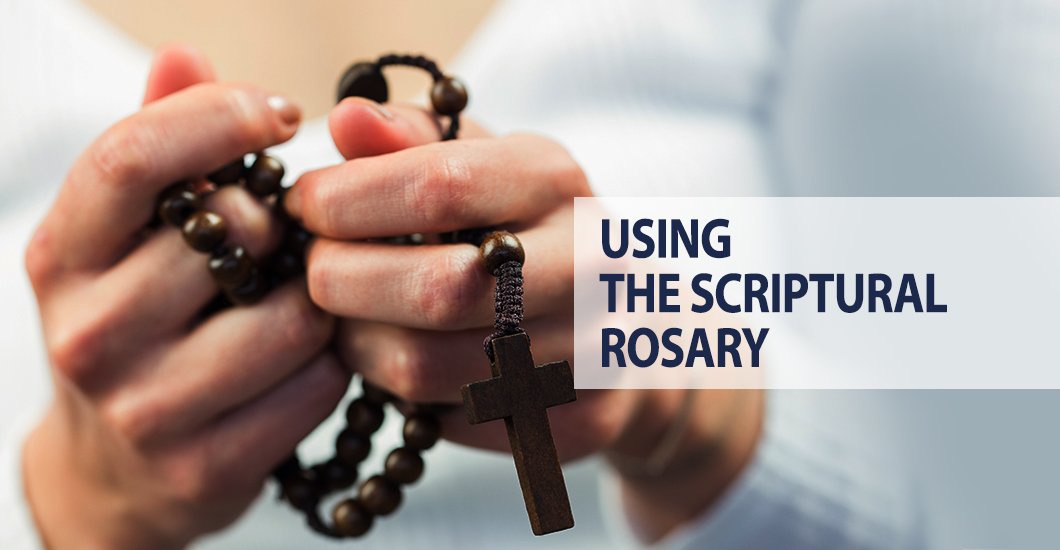Trending Articles
Using the Scriptural Rosary
In 2013, while I conducted my annual spring cleaning, I discovered a pamphlet by Marian Press titled “Pray the Rosary.” Since I had not said the Rosary since childhood, I thought this may be the Lord’s way of nudging me to start again. After many years of being away from the Church, I had reverted to Catholicism with a renewed commitment at Easter 2011. The evening of the cleaning, I decided to commit to reciting the Rosary nightly.
At first, I fumbled as I tried to remember how to say the Rosary of my childhood. The pamphlet proved to be a very informative instruction guide for me; however, during the Hail Mary prayers for each mystery, I found myself struggling at times to keep my meditation focused on the mystery. Fortunately, the pamphlet displayed artwork and a biblical passage related to each mystery. I began reading the passage and glancing at the artwork while I said the prayers, which definitely assisted me in centering on the theme of each mystery. Nevertheless, the one verse did not seem to satisfy me, and I decided to use my Bible in conjunction with the Rosary. I would often read an entire Bible chapter related to each mystery before I said the prayers. I felt this made my prayer more powerful and authentic.
Within a few weeks, I paid a visit to the gift shop at my local parish. While browsing the various rosaries, among them I found a newly published booklet titled, “The Scriptural Rosary” by Regina Press. After quickly glancing through it, I knew that God had placed it there for me to find.
That evening, while reading the introduction, I was pleased to learn that in 2002, Pope John Paul II had suggested the use of scriptural verses to augment the Rosary in his apostolic letter, “Rosarium Virginis Mariae.” Pope John Paul II stated that the Rosary is essentially a compendium of the Gospel since it has the “depth of the Gospel message in its entirety.” His sentiments perfectly summarized what I was beginning to realize and to believe.
In “The Scriptural Rosary,” each mystery has a brief meditation prior to the Our Father prayer. Before each Hail Mary prayer, there is a scriptural verse of one or two sentences. What I discovered in this booklet was that most of the same Bible chapters I had been reading were broken down into ten smaller segments, which promoted focusing on one aspect of the mystery with each Hail Mary prayer. The majority of the passages were drawn from the Gospels. Remaining passages were extracted from both the Old Testament and the New Testament. Although there are No scriptural references for the Assumption and the Crowning, the booklet utilizes verses from Luke for the Assumption and verses from Revelation for the Crowning.
By reciting the scriptural Rosary nightly, I felt more spiritually refreshed and satisfied. Using the Word of God in conjunction with the Rosary enriched my meditative prayer process by allowing me to merge my love of scripture with my love of the Rosary. Afterward, I felt that I had been present and an authentic witness to each experience in the life of Jesus.
The following are several advantages the scriptural Rosary has in comparison to the traditional Rosary:
◗ Provides a solid biblical foundation for our meditative prayer.
◗ By utilizing the Word of God, God speaks to us through the Holy Spirit.
◗ The Christocentric nature of the Rosary is enhanced by the use of inspired scripture.
◗ Our Catholic beliefs are reinforced and solidified.
◗ Both lectio divina and Gospel contemplation can be easily combined with the Rosary.
◗ Visualization of the mystery is clarified and magnified.
◗ Our hearts are lifted up to God in meaningful prayer.
Pope John Paul II also stated that “no other words can ever match the efficacy of the inspired word” (Rosarium Virginis Mariae). He believed that the Word of God was timeless and “spoken for today” and for us. Although we have been told that the origins of the Rosary are rooted in the early Christian practice of reciting the 150 Psalms from the Psalter, there is no doubt that the Rosary’s real foundation is upon the life and mysteries of Christ as depicted to us in the Gospels and the remainder of the New Testament. The Pope clearly infers that this is why it seemed appropriate and necessary for him to add the Luminous Mysteries in 2002. Therefore, it is only a natural progression for us to transition from the repetition of the traditional Rosary to the scriptural Rosary that permits God to speak to our hearts.
Una Marie Catania is a military veteran and retired registered nurse who now enjoys freelance writing, nature photography, and caring for wildlife. Her main interests include Catholic apologetics, scriptural warfare, and promoting ecumenism with those of other faiths. Catania loves reading and studying Scripture. She lives in New Port Richey, Florida.
Latest Articles
Want to be in the loop?
Get the latest updates from Tidings!








